Better Boxers: 2020 BMW R1250RS & R1250R Review
BMW brings its innovative new ShiftCam 1250cc flat-Twin to the RS sport tourer, as well as the standard R model
I’ve been reviewing BMW’s flat-Twin boxer powered bikes since I started testing motorcycles in the late ’80s and have burbled around on historic versions too, dating back to a beater ’64 R60/S my now ex-husband gave me to ride (quite possibly because it was less traceable then cyanide). Through it all, the boxer, with its punch-punch rhythm and unique seesaw jig always felt like an old friend, no matter the sprinkling of magic German engineering dust, or the ambition of the motorcycle BMW built around it.
2020 BMW R1250RS & R1250R
| Engine | 19.0/20 |
| Suspension/Handling | 14.5/15 |
| Transmission/Clutch | 9.5/10 |
| Brakes | 9.0/10 |
| Instruments/Controls | 4.5/5 |
| Ergonomics/Comfort | 8.5/10 |
| Appearance/Quality | 9.75/10 |
| Desirability | 9.0/10 |
| Value | 8.0/10 |
| Overall Score | 91.75/100 |
So, as you can imagine, when the opportunity arose to be the first journalist in North America to put BMW’s newest boxer-powered sportbike, the R1250RS, through its paces, I cleared my schedule.
Heart of the Matter
BMW’s new ShiftCam 1250cc flat twin, first introduced in the R1250GS adventure bike and RT tourer last winter, comes with changes much deeper than the 50cc bump in displacement insinuates. We’re seeing slight bumps in displacement and power across many models this year, most, purely compensatory gains to offset power sure to be siphoned as new, more stringent emissions regulations come into play for Europe.
What the ShiftCam design represents is more of a full-on transformation. The payoff comes from utilizing a camshaft with two separate cam pairs to optimize and fuse power delivery. When you’re using low revs, partial-load cam profiles reduce valve lift and close any gaps in power delivery. Throw open the throttle, and the cam shifts to full-load profiles for maximum power development. The result is more usable power and tighter, more even distribution of that energy from commencement to redline. And we’re talking a good amount of get-up: a claimed 105 lb-ft of torque at 6250 rpm and 136 hp at 7750.
There’s no arguing that the ShiftCam is a peach: so smooth you hardly recognize its relation to the strident horizontally-opposed boxer of yore – and with tangible elasticity that makes this twin feel especially futuristic.
Body and Soul
If we’re calling the engine the heart of this motorcycle, then the chassis is the body and the bike’s performance, its soul. The RS is purely a sportbike. Not sharp-edged like its S1000RR sibling, but a solid canyon slayer with comfortable, neutral ergonomics that encourage longer rides. Steering is not overly quick, but very precise, and brakes – twin floating discs with 4-piston radial calipers up front and a single disc with a 2-piston floating caliper in the rear – provide phenomenal control.
Weighing in at a considerable 537 pounds fully prepped, the RS feels much lighter underway. And at a stop, its narrow waist offsets a lofty 32.3-inch seat height to allow this 5’10” rider solid footing. The RS’s generous 60.2-inch wheelbase coupled with a 43mm upside-down telescopic fork and rear cast aluminum swing arm, aided by BMW’s shaft-damping Paralever, provide rock-steady posture and predictable tracking through the roughest of corners.
And yeah, all that sounds a touch boring because there are no surprises here. BMW knows how to build a sound sport machine, and the RS is no less. What is something a buyer needs to figure out is how awesome you want your R1250RS to be. Basic awesome or awesome, awesome?
The Cost of Greatness
Whether we’re into it or not, rider aids are here to stay, and BMW offers a boatload.
Thing is, it sneaks you into needing options by sorting them into packages that are irresistible. The RS is the perfect example. Stock, it comes with the essentials: Basic ABS (switchable), 2 ride modes (Rain/Road), BMW’s switchable ASC (only wheelie when you want to), Dynamic Brake Control ( torque intervention to maximize braking power to rear wheel), and Hill Start Control. You also get the two-way adjustable windscreen (not that special, you need tools), super readable TFT display, LED lights, and so on.
Then come the “Packages.” I’ll cut to the chase and tell you you’re going to want the “Select Package” because it’s everything: Dynamic ESA (electronic suspension adjustment), DTC (lean sensor-equipped traction control), ABS Pro (cornering ABS), Gear Shift Assist Pro (a.k.a. up/down quick shifting), Keyless Ride, and additional “Pro” Rider modes including a mode that can be customized. The Select Package also integrates heated grips, cruise control, tire pressure monitoring, chrome exhaust and – get this – a handy-dandy center stand.
And yup, of course it’s a chunk of extra dough: $3150. And that doesn’t include the cooler-than-black paint package you’re going to add for a smaller bag of coins. So really, instead of the marketed $15,695 base price, know up front you’re going to spend about twenty grand for this bike.
With that out of the way, let’s talk about what all that extra money feels on the road.
Flirting with Perfection
Flying the RS in and out of slow traffic or over mountain roads is effortless and exhilarating, and since rider modes as well as traction control and ABS are switchable on the fly, you can dial in your ambition as you go. Adjustments are evidenced on a new 6.5-inch TFT that is super bright, clear and easy to navigate. BMW’s left-hand switchgear and intuitive thumbwheel take you through all settings including navigation of the bike’s infotainment capabilities. The TFT is housed in a new, sportier-looking fairing that incorporates twin LED headlights for 2020.
BMW’s quick shift system is fast and light, with low gear downshifts much more snickable than when I first tested the technology in 2016. Four rider modes are available with the premium package: Rain, Road, Dynamic Pro and Custom. While I didn’t have time to invent my perfect setup, I found riding in Road excellent for all real world conditions, saving Dynamic Pro’s sharper throttle response and firmer stance for the most aggressive rips.
Three preload settings are available: solo rider, solo rider with luggage and two-up, the latter reminding you this rocket is intended to travel. Other hints include a hardwired docking cradle intended to receive BMW’s Navigator VI GPS system (yes, of course, more dough: $973 + monthly fee for updates) as well as a luggage rack and nubs and guards to receive BMW’s Touring Side Cases ($1461).
Sadly, I didn’t get the chance to take the RS on an extended trip, but I did spend four days using it as my sole means of transport and found it very comfy, with neutral nearly-upright ergos, plenty of room behind the cylinders for my longer-than-average legs and a reasonably pliant saddle. If given the chance, I would load it up and chase the sunset any day.
Those of you familiar with my review style know I don’t shy away from tearing into a bike when it deserves it. As a tester, the only challenge in writing up the R1250RS has been figuring out how to not make it sound like ad copy.
It is that good. Sleek, lively, sophisticated, versatile. No groans except for the deceptive pricing.
R1250R Option
When I turned in the R1250RS, I was happy to get a chance to try the new R1250R naked standard for an afternoon.
You know that thing that happens when you get married, and then someone shows up who’s extra hot and interesting? That was my experience with my time on the R. Given the choice up front, I would have opted to spend the majority of my time styling around on the very on-trend, fast, fun, and undecidedly more versatile R version.
What a bike. All the good stuff I said about the RS, but in a more classic package, with a more relaxed rake and upright ergos. I rode an especially stylish version: BMW’s new “Option 17 Spezial” (that’s not a typo) style package with the coolest Bronze Metallic paint and a brown stitched-pleather seat that added $1,200 to the R’s price.
With all the premium electronics and riders aids, plus the cruise control and heated grips, the R came with retail tag of $19,640. The RS tested here, with its interesting Yellow Matte paint package, was comparably priced at $19,840. Less its Spezial treatment, the R is $1600 less, a considerable difference.
Change is Good
Back when I first tested BMW’s flat twin in 1988, it was straddling the frame of a newly-revised R100GS. The big news about the bike, still carbureted and wearing a rear drum brake, was the introduction of BMW’s paralever swingarm, a magical fix for the shaft jacking effect that had previously marred performance.
It was a good change.
2020’s ShiftCam 1250 is in the same league of upgrades. While there was nothing wrong with the previous liquid-cooled 1200cc boxer, there is even more right about its successor.
While neither of these new models are bargain priced, the fact they are powered by BMW’s brand-new, best-ever boxer engine and equipped with class-leading components and electronics, the relevance of your investment is sure to last a minute. Or a lifetime, if you count the good times you’ll have – the only benefit BMW can’t charge you extra for.
2020 BMW R1250RS & R1250R
+ Highs
- Big jump in engine performance
- Class leading electronics suite
- Friendly, approachable manners
– Sighs
- Pricey in top spec
- Deserves electric windscreen
- GPS cradle is a blight w/o $973 BMW Navigator VI
In Gear
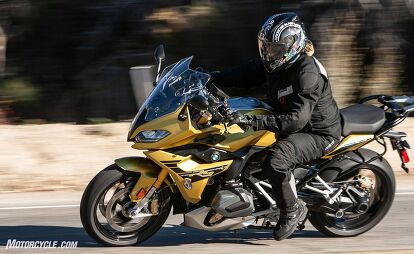
Helmet: Speed & Strength SS1600 American Beauty CA$280
- Suit: 2019 Aerostich Roadcrafter $1,157
- Boots: Sidi Adventure II $350
Gloves: RSD Barfly
Specifications | 2020 BMW R1250RS | 2020 BMW R1250R |
|---|---|---|
| Engine Type | Air/liquid-cooled 4-stroke flat twin engine, double overhead camshaft, one balance shaft and variable engine timing system BMW ShiftCam | |
| Bore x Stroke | 102.5 mm x 76 mm | |
| Capacity | 1254 cc | |
| Horsepower | 136 hp at 7750 rpm (claimed) | |
| Torque | 105 lb-ft at 6250 rpm (claimed) | |
| Compression ratio | 12.5:1 | |
| Engine Management | Electronic fuel injection with ride-by-wire throttle system | |
| Emission control | Closed-loop 3-way catalytic converter, emission standard EU-4 | |
| Fuel consumption | 50 mpg (claimed, WMTC) | |
| Clutch | Multi-plate wet clutch, hydraulically operated | |
| Transmission | Constant-mesh 6-speed gearbox with helical cut gears | |
| Drive | Shaft drive | |
| Frame | Two section frame, front – and bolted on rear frame, load bearing engine | |
| Front Suspension | 45mm upside-down telescopic fork, 5.5 inches of travel | |
| Rear Suspension | Cast aluminum single-sided swing arm with BMW Paralever; WAD strut (travel-related damping), spring pre-load hydraulically adjustable (continuously variable) via handwheel, rebound damping adjustable, 5.5 inches of travel | |
| Wheelbase | 60.2 inches | 59.6 inches |
| Trail | 4.4 inches | 4.9 inches |
| Rake | 27.7° | |
| Front Wheel | 3.50″ x 17″ cast aluminum wheel | |
| Rear Wheel | 5.50″ x 17″ cast aluminum wheel | |
| Front Tire | 120/70 ZR 17 | |
| Rear Tire | 180/55 ZR 17 | |
| Front Brake | Dual floating disc brakes, 4-piston radial calipers, diameter 320 mm | |
| Rear Brake | Single disc brake, diameter 276 mm, dual-piston floating caliper | |
| ABS | BMW Motorrad Integral ABS (part-integral, can be switched off) | |
| Length | 86.7 inches (2,202 mm) | 85.2 inches (2,165 mm) |
| Width (incl. mirrors) | 36.4 inches (925 mm) | 34.6 inches (925 mm) |
| Height (excl. mirrors) | 49.4 inches (1,255 mm) | 51.2 inches (1,300 mm) |
| Seat height | 32.3″ | |
| Curb Weight | 536 lbs (claimed) | 527 lbs (claimed) |
| Fuel Capacity | 4.8 gallons | |
More by Jamie Elvidge



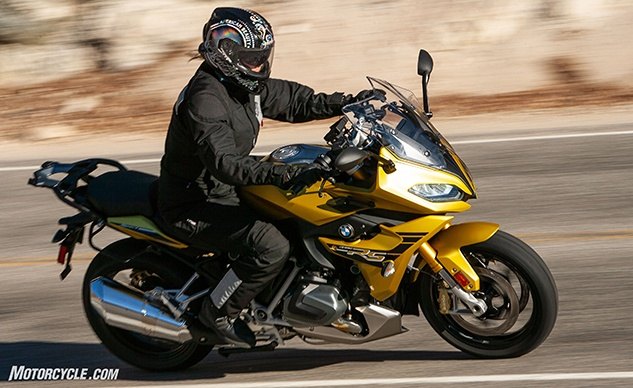

































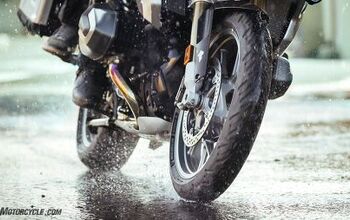
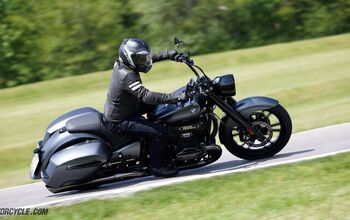
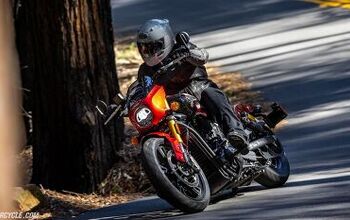

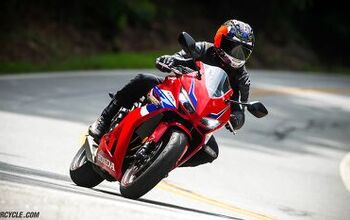
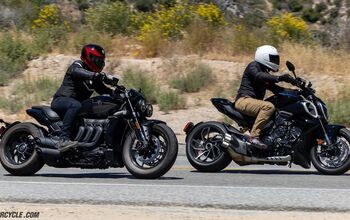

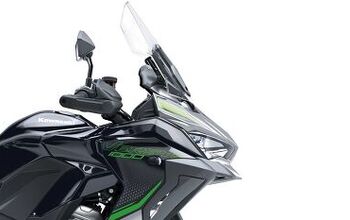

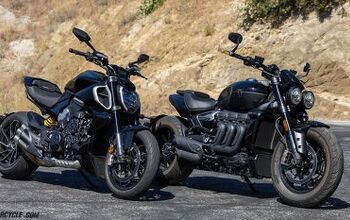
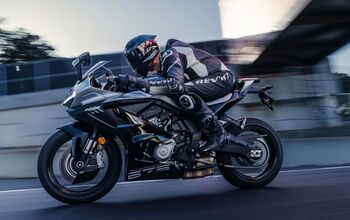


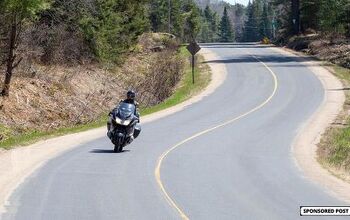
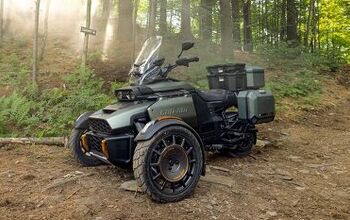
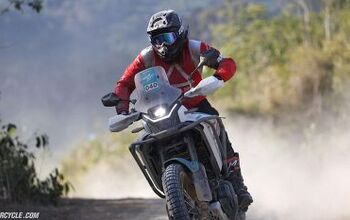


Comments
Join the conversation
Great to see Jamie on motorcycle.com!
I’m good with it but make mine oil/air cooled please. (Even if it costs 20bhp)